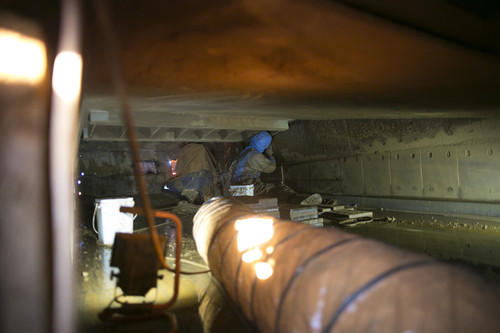Confined Space Ventilation: What Size Unit Do I Need?
Breathing is an automatic process and a part of our everyday lives, but we don’t think too much about it until we need to. Improper ventilation in a confined space means that workers may breathe in gases and toxins that can cause illness and death. The proper sizing of a blower unit can help you comply with confined space ventilation requirements.
When Does Confined Space Ventilation Matter?
Confined space ventilation always matters. OSHA's standard for confined spaces (1910.146 Permit Required Confined Spaces) states that if a gas detector indicates an atmospheric hazard, no workers are allowed to enter a space. Employees also cannot enter a space until forced air ventilation is used to eliminate atmospheric hazards, and that ventilation must continue until all employees have left the workspace.
How Ventilation Blowers Work
Confined space ventilation is a straightforward process, especially if you have a system like the Allegro Air Bag All-in-One Ventilation System that gives you everything you need to get started. Forced air ventilation is a matter of getting the blower duct well into the space and turning on the blower. After some time, test the space again for hazards, and if it’s clean, leave the blower on and enter the space to work. Where it can get complicated is that there are different kinds of ventilation blowers in an array of options for different confined spaces. Ventilation blowers come in power supply options like gas, pneumatic, or electric that you need to think about (the Allegro Industries Metal Venturi Blowers can use compressed air or saturated steam as the power source).
What is Your Confined Space Like?
When investing in confined space ventilation, it’s important to be familiar with intended application. The size and configuration of your confined space is important to consider The space may be long, or perhaps quite deep. It is good practice to locate the duct outlet at the furthest or deepest point. As you add duct length, airflow will be reduced, so consider how much ducting you’ll need and how that will affect ventilation. Areas with flammable materials or atmospheres have unique hazards and specific equipment requirements, so look for ventilation blowers and accessories that are spark-proof and explosion-proof.
How to Calculate What Size Blower You Need
A prime consideration with confined space ventilation blowers is the cubic feet per minute (CFM) delivery rate. For example, the Allegro 8 in. Confined Space 25 ft. Blower Ducting offers these CFM delivery rates: 831 for free air, 709 for one 90-degree bend, and 586 for two 90-degree bends. Both the length of duct and the number of bends add resistance to the flow of air. This reduces the effective output
To calculate the minimum CFM rate that your space needs, you need the cubic feet in the space and the number of air changes per hour (ACH) that are required (which varies depending on state requirements). Multiplying those two numbers together gets your total CFM delivery rate; dividing your total CFM delivery rate by 60 will get you the minimum CFM delivery rate you need. When buying a blower, choose one that meets or exceeds that number. All blowers that meet your requirement will do your job, but a higher CFM blower will get it done faster.
Consider a tank that is a 10 foot cube (10ft x 10ft x 10ft), which equals 1,000 cubic feet. A common ACH is 20. You need 333 cubic feet per minute to meet the ACH requirement in this example. Please recall that the CFM number is after accounting for duct length and any bends. More is better, both in terms of CFM and ACH.
Meeting Ventilation in Confined Space Requirements with PK Safety
The safety experts at PK Safety can help your team breathe easier whenever you do a job. Whether you need ventilation blowers, other personal protective equipment, or someone to answer your worksite safety questions, PK Safety can help. Contact us online or call 800.829.9580.
Recent Posts
-
Promoting Safety: National Work Zone Awareness Week is April 15-19, 2024
Each year, the National Work Zone Awareness Week (NWZAW) places the spotlight on the importance o …Apr 11th 2024 -
Understanding 4 Gas Monitors: How They Work & Why They Are Important
In today’s increasingly dynamic industrial landscape, 4 gas monitors have emerged as critical com …Apr 8th 2024 -
April Showers Require Workers to Wear Hi-Vis Safety Rain Gear
While April showers bring May flowers, they also bring challenges, particularly for those working …Apr 1st 2024





